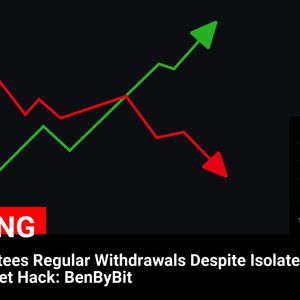After a thrilling surge, the EUR/USD pair is taking a breather. Is this just a temporary pause, a technical correction before another leap, or a sign of deeper shifts in the Forex trading landscape? Let’s dissect the latest price analysis to understand what’s driving this pullback and what it means for traders like you. Decoding the EUR/USD Technical Correction: What’s Happening? Following a robust rally that saw the EUR/USD pair climb for four consecutive days and gain over 1.50%, we’re now witnessing a slight retreat. On Monday, the pair edged down by 0.15%, settling around 1.0475. This isn’t necessarily a cause for alarm; in fact, many analysts view this as a healthy technical correction . Think of it as the market taking a necessary pause to consolidate gains before potentially making its next move. Here’s a breakdown of why this pullback is considered a technical correction : Natural Breather: After a significant upward movement, it’s common for prices to retrace slightly. This allows the market to digest the previous gains and prevents overheating. Profit-Taking: Traders who profited from the recent rally might be taking some chips off the table, leading to temporary selling pressure. Absence of Fresh Catalysts: The market might be lacking new, strong drivers to push the EUR/USD higher immediately, resulting in a period of consolidation. Key Technical Indicators: Still Bullish Despite the Dip? Despite the current pullback, several technical indicators suggest that the underlying bullish trend for EUR/USD might still be intact. Let’s examine some crucial signals: 20-day Simple Moving Average (SMA): The EUR/USD pair remains comfortably above the 20-day SMA. This is a significant bullish sign, indicating that even with the current dip, the pair is still trading above its recent average price. Historically, price levels around the 20-day SMA often attract buyers looking for opportunities to enter or add to their positions. Relative Strength Index (RSI): The RSI, a momentum indicator measuring the magnitude of recent price changes, has eased to 59. While down from higher levels, it remains in positive territory (above 50). This suggests that while momentum has slowed, it hasn’t flipped to bearish. An RSI above 50 generally indicates that buying pressure is still stronger than selling pressure. Moving Average Convergence Divergence (MACD): The MACD histogram, which illustrates the difference between the MACD line and the signal line, is currently flat with green bars. This points towards consolidation rather than a strong bearish shift. Green bars on the MACD histogram typically suggest that bullish momentum is still present, albeit potentially weakening or pausing. In essence, these indicators suggest that the current pullback is more of a pause within an uptrend rather than a complete trend reversal. However, it’s crucial to watch for confirmation and be prepared for potential shifts. EUR/USD Critical Price Levels: Support and Resistance Zones Understanding key support levels and resistance zones is vital for navigating this technical correction . These levels can act as potential turning points for price movements. Resistance Levels (for Bulls to Regain Control): 1.0500: This psychological level is the immediate hurdle for bulls. Recapturing and holding above 1.0500 would signal renewed bullish momentum and potentially pave the way for further gains. Support Levels (Where Buyers Might Step In): 1.0450: This is the immediate support level . A hold above this level would reinforce the idea of a temporary pullback. 1.0420: The next support level down. Breaching this could indicate a deeper correction. 1.0400 (Near 20-day SMA): This level, close to the 20-day SMA, is a significant support zone . Many analysts anticipate buyers to become active around this level, potentially halting further declines. Here’s a table summarizing these key levels: Level Type Price Significance Immediate Resistance 1.0500 Psychological level, bullish trigger Immediate Support 1.0450 First line of defense for bulls Next Support 1.0420 Deeper correction level Key Support Zone 1.0400 (near 20-day SMA) Strong buyer interest expected Navigating EUR/USD Trading During a Technical Correction So, how should traders approach EUR/USD during this technical correction ? Here are a few actionable insights for your Forex trading strategy: Monitor Support Levels Closely: Keep a close watch on the support levels mentioned, especially 1.0450 and 1.0400. Price action around these levels will provide clues about the strength of the pullback and potential for a bounce. Wait for Confirmation: Avoid impulsive decisions. Wait for confirmation signals, such as a break back above 1.0500 or bullish candlestick patterns forming at support levels , before initiating new long positions. Manage Risk: Technical corrections can sometimes turn into deeper reversals. Employ robust risk management techniques, including setting stop-loss orders, to protect your capital. Consider Short-Term Opportunities: While the overall trend might still be bullish, short-term traders could explore opportunities in both directions depending on price action at key levels. However, always trade with caution and within your risk tolerance. Conclusion: Is the EUR/USD Pullback a Buying Opportunity? The current pullback in EUR/USD appears to be a standard technical correction after a strong rally. Technical indicators and key support levels suggest that the bullish trend might still be intact. For astute Forex trading enthusiasts, this dip could indeed present a powerful buying opportunity, provided that support levels hold and bullish momentum returns. Keep a watchful eye on price action, respect risk management, and stay informed to navigate these market wobbles effectively. To learn more about the latest Forex market trends, explore our articles on key developments shaping currency trading strategies and market volatility.



















